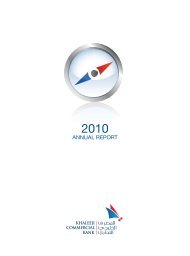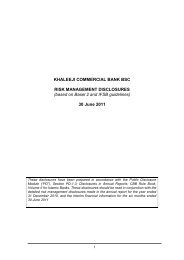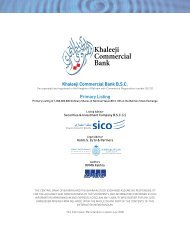2011 Annual Report - Khaleeji Commercial Bank BSC
2011 Annual Report - Khaleeji Commercial Bank BSC
2011 Annual Report - Khaleeji Commercial Bank BSC
Create successful ePaper yourself
Turn your PDF publications into a flip-book with our unique Google optimized e-Paper software.
KHALEEJI COMMERCIAL BANK <strong>BSC</strong><br />
NOTES TO THE CONSOLIDATED FINANCIAL STATEMENTS<br />
for the year ended 31 December <strong>2011</strong><br />
2. SIGNIFICANT ACCOUNTING POLICIES (continued)<br />
l. Impairment of assets (continued)<br />
Equity investments carried at fair value through equity (FVTE) (continued)<br />
For FVTE investments carried at cost, the Group makes an assessment of whether there is an objective evidence of<br />
impairment for each investment by assessment of financial and other operating and economic indicators. Impairment is<br />
recognised if the estimated recoverable amount is assessed to be below the cost of the investment.<br />
Other non-financial assets<br />
The carrying amount of the Group’s assets (other than for financial assets covered above), are reviewed at each statement<br />
of financial position date to determine whether there is any indication of impairment. If any such indication exists, the asset’s<br />
recoverable amount is estimated. The recoverable amount of an asset is the greater of its value in use or fair value less<br />
costs to sell. An impairment loss is recognised whenever the carrying amount of an asset exceeds its estimated recoverable<br />
amount. Impairment losses are recognised in the income statement. Impairment losses are reversed only if there is an<br />
indication that the impairment loss may no longer exist and there has been a change in the estimates used to determine the<br />
recoverable amount.<br />
m. Customers’ current accounts<br />
Balances in current (non-investment) accounts are recognised when received by the <strong>Bank</strong>. The transactions are measured<br />
at the cash equivalent amount received by the <strong>Bank</strong> at the time of contracting. At the end of the accounting period, the<br />
accounts are measured at their book value.<br />
n. Equity of investment account holders<br />
Equity of investment account holders are funds held by the <strong>Bank</strong> in unrestricted investment accounts, which it can invest at its own<br />
discretion. The investment account holder authorises the <strong>Bank</strong> to invest the account holders’ funds in a manner which the <strong>Bank</strong><br />
deems appropriate without laying down any restrictions as to where, how and for what purpose the funds should be invested.<br />
The <strong>Bank</strong> charges management fee (Mudarib fees) to investment account holders. Of the total income from investment<br />
accounts, the income attributable to customers is allocated to investment accounts after setting aside provisions, reserves<br />
(Profit equalisation reserve and Investment risk reserve) and deducting the <strong>Bank</strong>’s share of income as a Mudarib. The<br />
allocation of income is determined by the management of the <strong>Bank</strong> within the allowed profit sharing limits as per the terms<br />
and conditions of the investment accounts. Administrative expenses incurred in connection with the management of the<br />
funds are borne directly by the <strong>Bank</strong> and are not charged separately to investment accounts.<br />
Investment accounts are carried at their book values and include amounts retained towards profit equalisation and<br />
investment risk reserves. Profit equalisation reserve is the amount appropriated by the <strong>Bank</strong> out of the Mudaraba income,<br />
before allocating the Mudarib share, in order to maintain a certain level of return to the deposit holders on the investments.<br />
Investment risk reserve is the amount appropriated by the <strong>Bank</strong> out of the income of investment account holders, after<br />
allocating the Mudarib share, in order to cater against future losses for investment account holders. Creation of these<br />
reserves results in an increase in the liability towards the pool of unrestricted investment accounts.<br />
o. Restricted investment accounts<br />
Restricted investment accounts represents assets acquired by funds provided by holders of restricted investment accounts and<br />
their equivalent and managed by the <strong>Bank</strong> as an investment manager based on either a Mudaraba contract or agency contract.<br />
The restricted investment accounts are exclusively restricted for investment in specified projects as directed by the investments<br />
account holders. Assets that are held in such capacity are not included as assets of the <strong>Bank</strong> in the consolidated financial statements.<br />
p. Financial guarantees<br />
Financial guarantees are contracts that require the Group to make specified payments to reimburse the holder for a loss<br />
it incurs because a specified debtor fails to make payment when due in accordance with the terms of a debt instrument. A<br />
financial guarantee contract is recognised from the date of its issue. The liability arising from a financial guarantee contract<br />
is recognised at the present value of any expected payment, when a payment under the guarantee has become probable.<br />
42<br />
<strong>Annual</strong> <strong>Report</strong> <strong>2011</strong>










